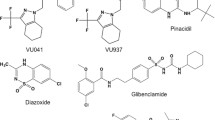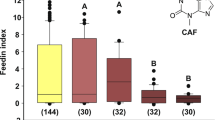Abstract
THE analyses of Bishop1, Boné2, Brecher3, Drilhon4, Tobias5, and others show that in phytophagous insects the potassium concentration in the hæmolymph is always high and exceeds 70 mM/litre in some instances. Such values would depolarize vertebrate or crustacean nerve fibres and stop conduction6. Insect nerves may have different properties in regard to potassium, or this may be bound in some way to the organic constituents of the blood. Alternatively7, the fibres may be protected from the high blood potassium by a sheath capable of ionic regulation, providing the axons with a local environment containing a lower potassium concentration than that of the blood.
Similar content being viewed by others
References
Bishop, G. H., J. Biol. Chem., 66, 77 (1926).
Boné, G. J., Ann. Soc. Roy. Zool. Belg., 75, 123 (1944).
Brecher, L., Biochem. Z., 211–2, 40 (1929).
Drilhon, A., C.R. Soc. Biol., Paris, 115, 1195 (1934).
Tobias, J. M., J. Cell. and Comp. Physiol., 31, 143 (1948).
Cowan, S. L., Proc. Roy. Soc., B, 115, 216 (1934).
Pringle, J. W. S. (personal communication).
Author information
Authors and Affiliations
Rights and permissions
About this article
Cite this article
HOYLE, G. High Blood Potassium in Insects in Relation to Nerve Conduction. Nature 169, 281–282 (1952). https://doi.org/10.1038/169281a0
Issue Date:
DOI: https://doi.org/10.1038/169281a0
- Springer Nature Limited
This article is cited by
-
Connective tissue ofApis mellifera: An ultrastructural study
Insectes Sociaux (1976)
-
High permeability of insect blood-brain barrier to alcohols demonstrated by an electrophysiological technique
Experientia (1975)
-
Defects in the experimental design of radioisotopic studies on the insect nerve cord
Zeitschrift f�r Vergleichende Physiologie (1971)
-
Insect mucosubstances. II. The mucosubstances of the central nervous system
The Histochemical Journal (1971)
-
The regulation of sodium ions in the central nervous system of the herbivorous insect Carausius morosus
Zeitschrift f�r Vergleichende Physiologie (1970)





